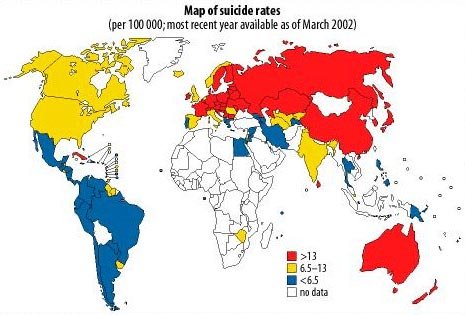
Suicide is one of the leading causes of death in countries around the world. One person takes their own life every 40 seconds. This equates to over 800,000 deaths by suicide across the world every year. 70-80% of all suicide deaths are male.
In Australia:
- Suicide is the largest single killer of men under the age of 44.
- One third of all deaths by young men is due to suicide.
- Close to 80% of all suicides in Australia are Men.
- The suicide rate is the highest it has been in the past decade.
In the US:
- Suicide is the 10th leading cause of death
- Men die by suicide 3.5x more often than women.
- White males accounted for 7 of 10 suicides in 2015.
- Firearms account for almost 50% of all suicides
- The rate of suicide is highest in middle age — white men in particular. Source
These statistics are not just confined to Australia and the USA but are repeated in many countries all across the world.

Source
Why are suicide rates much higher in Males?
One of the biggest issues facing men is that the help is often just not there. Things have improved over the past decade, but seeking assistance is not something men will do. ‘She’ll be right’ is a common response for many Australian men.
"It's the idea that to be a man is to be tough, to be strong, to be invulnerable, to be heterosexual, to be in control, to avoid feelings, and so on. The pressure on men to be stoic can "stuff up men's physical and emotional health".
Dr Flood, Huffington Post
Women are actually more likely to suffer from depression, but more likely to seek help when they encounter trouble. The uncomfortable truth is that stereotypical forms of masculinity are killing men.
In the late 1990s, it was men in their 20s who were most at risk from suicide; today it is men in their 40s. It's the same cohort, and is evidence of "scarring": of being unemployed at a young age, and suffering from long-term consequences, including higher rates of unemployment and lower wages in later life, as well as mental distress. SOURCE
Why do I have such a passion for raising awareness of Male Suicide? The answer is I lost a great friend to suicide. It’s a hard story to tell, but an important one for me to give you context and the reasons why awareness of this issue is needed.
Let me tell you his story:
Brad’s Story
Brad and I were childhood mates. We had known each other since the beginning of the fourth grade. We loved kicking the footy and running amok. I would ride up the hill from my house to hang out with him. We would play the old Nintendo 64, Donkey Kong, I think and muck around on the farm. We would sometimes head down to the quarry at the end of his street on weekends and pretend we were driving the trucks and front-end loaders, everything was always unlocked in the early 90’s.
I remember finding some nudey mags one weekend in one of the trucks, Playboy it think, and Brad and I taking them to high school to share with all of our mates. The next weekend we all headed back up to the quarry to look for some more ‘paper porn’, only to find that the ‘smoko’ room had been left unlocked and there was a fridge full of cold beer inside. That was my first experience of getting drunk, and it was Brad’s too. We were only 13 years old.
Brad loved bodyboarding and we both made it into the state schoolboys finals. We got to head down to Clifton Beach near Hobart, sleep in a scout hall, accidentally smashing one of the windows and then place in the final of the competition the next day.
Me surfing in the Competition at Clifton Beach (circa. 1994)
Brad and I took the same Agricultural studies course in Year 12. I would pick him up each morning in my orange Holden Torana and we’d head off the school. We planted the idea of growing opium poppies on the school’s agricultural plot (legally of course), in the teachers head, which earnt the school around $30,000. This gave us free reign when we took on our big investigation for the year and started the Rainbow Trout breeding program at the school. It cost a mint to get it up and running and it is still going to this very day.
Me and the old Torana
After year 12, I left for University and Brad went onto TAFE to further his agricultural studies. I didn’t get to see him much as I moved 3 hours away from him and we both found steady girlfriends, but we caught up as much as we could.
One weekend I went around to his house for a few beers and he didn’t seem the normal happy-go-lucky guy he normally was. He seemed a bit withdrawn and didn’t talk as much as he usually did. I asked if he was ok and he said he was. I didn’t think anything of it at the time and I headed back to university the next day thinking nothing of it.
Two weeks later I got a call from my mother. She told me that Brad had broken up with his girlfriend the week after I last saw him. After a few days of Brad’s Dad not being able to get him on the phone, he went around to see Brad to see how he was doing.
There he found Brad hanging from a rope in his lounge room dead. That was 20 years ago this year. We were only 19 years old.
There were no signs of depression or anything else that had alerted his family that anything was this seriously wrong. They knew he had a relationship breakup but thought he was handling it ok.
I always think to myself, what could I have done? Why didn’t I notice the signs? What if… What if…..
Suicide Warning Signs
There are many comprehensive lists to be found, but I particularly like the list below from Webmd on Recognising Suicidal Behaviour.
Any of the following could be potential warning signs for suicide:
- Excessive sadness or moodiness: Long-lasting sadness, mood swings, and unexpected rage.
- Hopelessness: Feeling a deep sense of hopelessness about the future, with little expectation that circumstances can improve.
- Sleep problems.
- Sudden calmness: Suddenly becoming calm after a period of depression or moodiness can be a sign that the person has made a decision to end his or her life.
- Withdrawal: Choosing to be alone and avoiding friends or social activities also are possible symptoms of depression, a leading cause of suicide. This includes the loss of interest or pleasure in activities the person previously enjoyed.
- Changes in personality and/or appearance: A person who is considering suicide might exhibit a change in attitude or behaviour, such as speaking or moving with unusual speed or slowness. In addition, the person might suddenly become less concerned about his or her personal appearance.
- Dangerous or self-harmful behaviour: Potentially dangerous behaviour, such as reckless driving, engaging in unsafe sex, and increased use of drugs and/or alcohol might indicate that the person no longer values his or her life.
- Recent trauma or life crisis: A major life crises might trigger a suicide attempt. Crises include the death of a loved one or pet, divorce or break-up of a relationship, diagnosis of a major illness, loss of a job, or serious financial problems.
- Making preparations: Often, a person considering suicide will begin to put his or her personal business in order. This might include visiting friends and family members, giving away personal possessions, making a will, and cleaning up his or her room or home. Some people will write a note before committing suicide. Some will buy a firearm or other means like poison.
- Threatening suicide: From 50% to 75% of those considering suicide will give someone -- a friend or relative -- a warning sign. However, not everyone who is considering suicide will say so, and not everyone who threatens suicide will follow through with it. Every threat of suicide should be taken seriously.

Suicide prevention, particularly for males, is something, that until recently, has not garnered the attention or focus is needs.
It is a ‘Silent Killer’
There are now many organisations that deal with and address suicidal tendencies but if no-one seeks help, it is usually too late.
If you have a mate or family member you are concerned about, please take a look at the following pages, or contact the relevant authority in your country.
Further Information:
Suicide Prevention
Recognising Suicide Warning Signs
Suicide Prevention: What are the Warning Signs
About Suicide: Warning Signs, Risk Factor, Protective Factors
A suicidal person may not ask for help, but that doesn't mean that help isn't wanted or needed. People who take their lives just want to stop hurting.
Suicide prevention starts with recognising the warning signs and taking them seriously. It is up to us to keep an eye on our friends and family. Men rarely seek help or want to talk about their feelings.
Talking openly about suicidal thoughts and feelings can save a life.
Please resteem and spread awareness of this 'silent killer' affecting our society today.
Thanks for reading.

